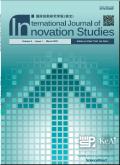揭示吸收能力、创新和财务绩效之间的关系:一项纵向研究
IF 5.3
Q2 MANAGEMENT
引用次数: 0
摘要
本研究探讨了非金融企业吸收能力、创新和财务绩效之间错综复杂的关系。研究使用了 COMPUSTAT 的数据,时间跨度为 1966 年至 2020 年,包括 25,392 个观测值,并使用托宾 Q 作为财务绩效的衡量指标。以研发费用与总收入之比衡量的吸收能力对创新和财务绩效都有显著的正向直接影响。然而,用无形资产总额的自然对数表示的创新对财务绩效有负面影响,并在吸收能力与财务绩效之间的正向关系中起中介作用。这揭示了创新在吸收能力与财务绩效关系中的抑制作用。这挑战了创新必然导致财务业绩改善的传统观念,凸显了其中微妙的动态关系。研究强调了短期收益与长期潜力之间的权衡,强调了在当今竞争格局下组织成功的复杂性。本文章由计算机程序翻译,如有差异,请以英文原文为准。
Unravelling the relationship between absorptive capacity, innovation, and financial performance: A longitudinal study
This study explores the intricate relationships among absorptive capacity, innovation, and financial performance in nonfinancial firms. Using data from COMPUSTAT spanning 1966 to 2020, including 25,392 observations, Tobin's Q is used as a measure of financial performance. Absorptive capacity, measured by the ratio of research and development expenses to total revenue, has a significant positive direct impact on both innovation and financial performance. However, innovation, represented by the natural logarithm of total intangible assets, has a negative influence on financial performance and mediates the positive relationship between absorptive capacity and financial performance. This reveals the suppressive role of innovation in the absorptive capacity-financial performance relationship. This challenges the conventional belief that innovation invariably leads to improved financial outcomes, highlighting the nuanced dynamics involved. The study underscores the trade-offs between short-term gains and long-term potential, emphasizing the complexity of organizational success in today's competitive landscape.
求助全文
通过发布文献求助,成功后即可免费获取论文全文。
去求助
来源期刊

International Journal of Innovation Studies
Business, Management and Accounting-Strategy and Management
CiteScore
8.10
自引率
0.00%
发文量
23
审稿时长
19 weeks
 求助内容:
求助内容: 应助结果提醒方式:
应助结果提醒方式:


